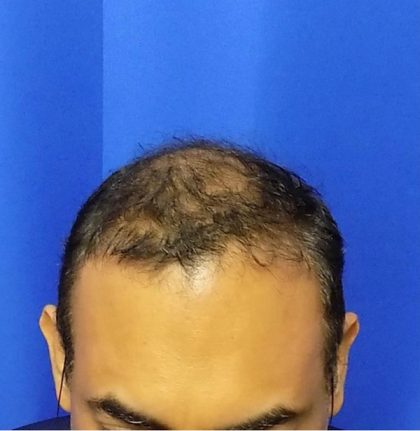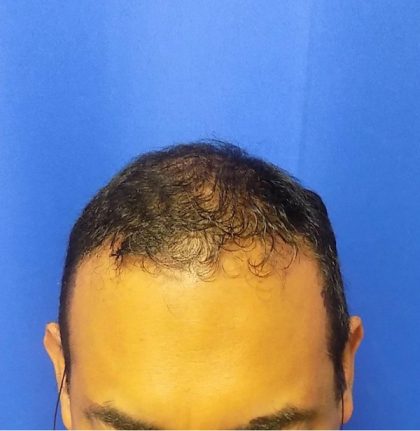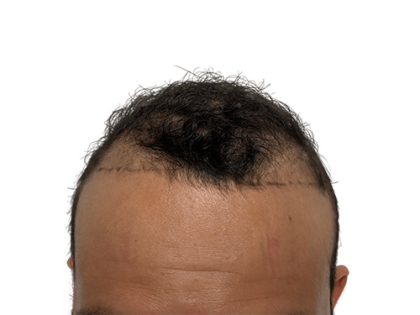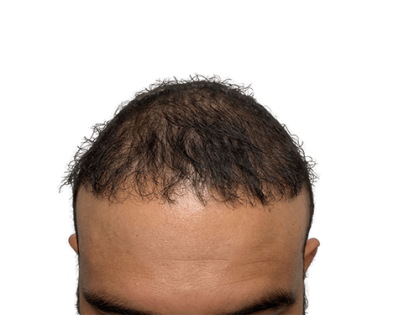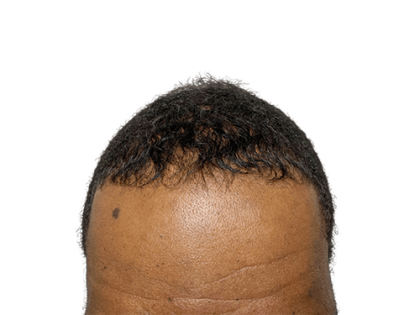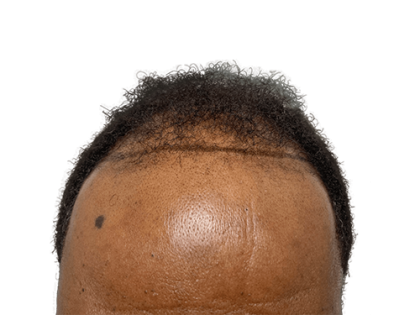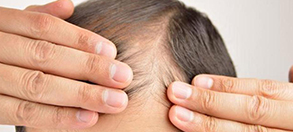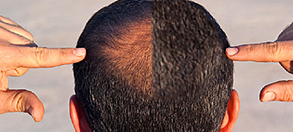Hair transplantation is a minimally invasive procedure that involves removing individual hair follicles from the back of the scalp to replenish hair density in the hairline or crown. Follicular Unit Extraction (FUE) is the most advanced hair restoration method that is effective for all genders and ethnicities, including African-American men. The procedure does not involve skin excision or result in an unsightly, long scar. Instead, advanced tools extract hair follicles with tiny incisions that only leave pin-size scars on the scalp. If you have any type of curly or African-American hair, FUE can work excellently for you. Our highly-trained hair technicians average 10 years of experience and are led by the combined decades of expertise of hair specialists Dr. Goran Jezic and Josh Simpson, PA-C. To find out if a hair transplant is right for you, call for a consultation at our office in Houston or Austin, TX at (713) 864-2300 or request a virtual consultation online. We can’t wait to help you feel like your most attractive and confident self.
Before and After Photos
African American Hair Loss
African American and curly hair is unique and distinct in its texture, curl pattern, thickness, dryness, fragility, scalp sensitivity, porosity, growth rate, hair density, and susceptibility to breakage. Understanding these differences is crucial for providing effective and personalized hair care solutions.
Hair loss can be a distressing situation for anyone, but it can be particularly challenging for African-American men due to their hair characteristics and how hair loss can present more obviously. At the Houston Hair Transplant Center, we understand the specific needs and concerns of our patients and offer specialized hair transplant solutions tailored to their individual requirements.
What Causes Hair Loss?
Most of the time, gradual, patterned hair loss is the result of androgenetic alopecia– or male/female patterned hair loss- a hereditary condition where hair thinning occurs at the crown and/or hairline due to scalp sensitivity to androgens. These hormones cause inflammation at the site of hair follicles, leading to damage and degeneration. The condition is extremely common; about 80% of men will exhibit some form of it before the age of 70. (1)
Anatomy of the Hair Follicle
In order for hair transplantation to occur, one must harvest full follicles with all of their components intact. Follicular units are tiny structures that contain roughly 1 to 4 hair shafts, a “bulb” structure that has hair-producing cells, a sebaceous gland for lubrication, and a structure called an arrector pili that allows the hair/s to stand on end. The donor site, the area of harvesting the follicles, is usually at the back and sides of the head where the follicles are resilient against androgen hormones. The team will be sure to harvest and extract hair follicular units from various points to prevent the appearance of hair loss in the donor area.
What Happens During an FUE Procedure?
First, your hair transplant team at HHTC will shave the back of your scalp to gain better access to the follicles. Dr. Jezic will then administer a local anesthetic to the scalp so that the entire procedure is comfortable. The team will then administer micro punches using the NeoGraft or ATERA device in order to collect the hair follicles. These micro punches are tiny, superficial incisions of only 1 mm or less, so there is minimal damage to the scalp. Both of these devices are capable of collecting, suctioning, and preserving the follicles in a solution that will hold them until the team is ready to transplant them and place them into your recipient sites. Next, the team will make needle-like holes in the area of hair loss, ensuring that they are crafted in such a way that provides a more natural hairline and/or crown. Finally, the preserved hair follicles are placed within these newly fashioned sites, where they will slowly adapt to the new surrounding skin as each follicle’s bulb gains access to a new blood supply needed for nutrients.
FUE is a superior alternative to traditional FUT methods (Follicular Unit Transplantation) which involve taking off a strip of skin from the back of the head. The follicles are harvested from this strip of skin and the incision is closed with sutures. The scar is often not adequately hidden by the surrounding hair, and it can serve as an obvious indication that you have had a hair transplant.
Benefits of FUE for African American Men
There are many reasons African American men have gravitated towards this transformative procedure. Moreover, there could be other factors at play apart from androgenetic alopecia that have contributed to your hair loss. Tight hairstyles like dreadlocks, braids, and cornrows can place stress on the hair itself and further recede your hairline. In this case, you can often reverse the damage by changing up your hairstyle. However, if your hair doesn’t return to normal, or Dr. Jezic determines that genetics is the root cause, FUE could be the solution you have been looking for:
- FUE’s NeoGraft device harvests follicles with greater precision- a necessary requirement for Afro-descent “c-shaped” hair follicles.
- Dr. Jezic can easily create natural-looking results by implementing a lower, straighter hairline characteristic of African-American men, which can be a much simpler process than the “M” shaped hairline of other ethnicities.
- Significantly less invasive FUE methods mitigate the risk of keloid scarring, which is much more common in people with darker skin. (2)
- Due to the increased volume of coiled and curled hair strands, many African-American men do not require as many grafts, so the procedure may be more cost-effective.
- FUE techniques allow patients to wear their hair short, a common preference among African-American men.
- Due to the principle of donor dominance discovered by dermatologist Norman Orentreich in the 1950s, the transplanted hair follicles will retain their curly/coiled characteristics in their new location. (3)
- Dr. Jezic is knowledgeable about 4a, 4b, and 4c curly and coily hair types and how many individuals can exhibit a mix of these hair types. He will take care to restore areas of hair loss with the correct hair follicles that will flatter your aesthetic appearance as a whole.
Other Benefits of FUE
Many other aspects of the procedure are appealing to a wide range of patients for reasons unspecific to their hair type:
- The downtime is extremely minimal- Within a couple of days, you will be able to return to normal working activities.
- The donor site is evaluated- Dr. Jezic will evaluate a sample of the follicles from the back of your head to assess the quality of your donor site. This ensures that results are predictable and go according to plan.
- The transplanted hair is permanent– So long as you follow aftercare instructions, your newly grafted follicles should continue to grow hair for the rest of your life.
- You will notice significant results in just 3 months– Sometimes, men may experience “shock loss” which causes hair to fall out around the grafted area. This side effect is temporary, and the final results will settle in after about 6 months.
- Dr. Jezic can treat other areas of hair loss- men aren’t only concerned about their head hair. Some may be self-conscious about facial hair loss. Luckily, advancements in FUE technology have allowed patients to restore their beards (beard transplant), mustaches, and even eyebrows (eyebrow transplant).
Am I a Candidate?
Candidates for FUE include men and women of all ethnicities who have a predictable form of hair loss. Ideally, prospective patients should have no underlying medical concerns or autoimmune conditions that could interfere with the healing process. Those under the age of 21 may not qualify for FUE since they may have progressive hair loss (still losing hair). They may not get the permanent results they are looking to achieve due to this accelerated form of hair loss. People with other conditions like diffuse unpatterned alopecia (DUPA) have randomized hair thinning in various parts of the scalp, so their follicles may not be viable for a hair transplant.
Personal Consultation
During your consultation, Dr. Jezic will conduct a comprehensive scalp evaluation and hair loss assessment. This will allow him to thoroughly understand your specific hair loss patterns and whether or not you may be a good candidate for FUE. He will listen closely to your concerns, your preferred hairstyles, and the expectations you have of the procedure. At the time of your consultation, he will give you a rough estimate of the number of grafts you will require.
Cost of FUE in Houston
Since the total cost of your FUE is mostly dependent on the number of grafts you require, you will be able to get a cost estimate during your initial in-person consultation. At Houston Hair Transplant Center, we only offer patients multi-follicle grafts which provide patients with the most results at competitive prices. This means that each graft contains 1 to 3 hair follicles, on average.
To schedule your consultation at HHTC today, please get in contact with our locations in Houston, TX or Austin, TX at (713) 864-2300. Alternatively, you can reach a member of our staff who can readily answer any questions by phone or through our contact form. We also have a virtual consultation option available for those who live outside of Houston and want the convenience of an online Skype, FaceTime, or Zoom meeting.
If you would like to learn more about our hair transplantation services and philosophy, please take a look through our blog. If you feel ready to take the next step in your journey towards renewed confidence, consider the permanent, natural-looking results you can attain with the help of the knowledgeable team here at Houston Hair Transplant Center.
References
- Yang K, Tang Y, Ma Y, et al. Hair Growth Promoting Effects of 650 nm Red Light Stimulation on Human Hair Follicles and Study of Its Mechanisms via RNA Sequencing Transcriptome Analysis. Annals of Dermatology. 2021;33(6):553-561. doi:https://doi.org/10.5021/ad.2021.33.6.553
- Tchero H. Management of Scars in Skin of Color. PubMed. Published 2020. https://www.ncbi.nlm.nih.gov/books/NBK586105/
- Dua A, Dua K. Follicular unit extraction hair transplant. Journal of cutaneous and aesthetic surgery. 2010;3(2):76-81. doi:https://pubmed.ncbi.nlm.nih.gov/21031064/
